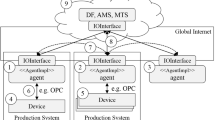Abstract
Global competition, shorter lead times and customer demands for increasing product variety have collectively forced the manufacturing enterprises to rapidly develop and introduce new products to obtain quick return on their investments. The variations in today’s manufacturing scenario are directly driven by the requirements for a product’s price, quality, delivery performance, customer choices, etc. As a consequence, adaptability, reflexivity and responsiveness are a common denominator for judging the competitive advantage of the manufacturing firms. The inclusion of these characteristics entices the implementation of the concepts of distributed artificial intelligence (DAI) and information-based manufacturing. Thus a synergized use of agent-based manufacturing (derived from DAI) and supporting information architecture is well suited in the contemporary manufacturing arena for dealing with variations and uncertainties. In this paper, a conceptual infrastructure for information-based control architecture is discussed and special emphasis is put on multi–level co-ordination.
Similar content being viewed by others
References
Cheng K, Harrison DK, Pan PY (1998) An internet based architecture of implementing design and manufacturing agility for rolling bearings. J Mater Process Technol 76:96–101
Booth R (1996) Agile manufacturing. Eng Manag J April:105–112
Jennings NR (1999) Agent–based computing: promise and perils. Proceedings of IJCAI’99, Stockholm, Sweden, pp 1429–1436
Jennings NR (2000) On agent–based software engineering. Artif Intell 117:277–296
Wooldridge M (1997) Agent–based software engineering. IEEE Proc Softw Eng 144(1):26–37
Chan FTS, Zhang J, Li P (2003) Agent– and CORBA–based application integration platform for an agile manufacturing environment. Int J Adv Manuf Technol 21:460–468
Jennings NR, Wooldridge M (2000) Agent–oriented software engineering. In: Bradshaw J (ed) Handbook of agent technology. AAAI/MIT Press, Cambridge, MA
Wooldridge M, Jennings NR (1995) Intelligent agents: theory and practice. Knowl Eng Rev 10(2):15–152
Bond AH (1988) Readings on distributed artificial intelligence. Morgan Kaufmann, San Mateo, CA
Castelfranchi C (1990) A point missed in multi–agent, DAI and HCI. Decentralised AI, pp 49–62
Jennings NR (1993) Commission and conventions: the foundation of co–ordination in multi–agent systems. Knowl Eng Rev 8(3):223–250
Gasser L (1991) Social conceptions of knowledge and actions: DAI foundations and open system semantics. Artif Intell 47:107–138
Gates WH (1999) Business at the speed of thought, using a digital nervous system. Warner Books, New York
Toh KTK, Harding JA (1999) An enterprise modelling CASE tool and data schema requirements for the selection of software support. Int J Prod Res 37(18):4079–4104
Weston RH (1998) Integration infrastructure requirements for agile manufacturing systems. Proc Inst Mech Eng B J Eng Manuf 212(B6):423–427
Cheng K, Pan PY, Harrison DK (2000) The internet as a tool with application to agile manufacturing: a web–based engineering approach and its implementation issues. Int J Prod Res 38(12):2743–2759
Ellsworth JH, Ellsworth MV (1996) The new internet business book. Wiley, New York
Sycara K, Zeng D (1996) Multi–agent integration of information gathering and decision support. 12th European Conference of Artificial Intelligence, John Wiley and Sons, pp 549–553
Rao AS, Georgeff MP (1993) A model–theoretic approach to the verification of situated reasoning systems. Proceedings of IJCAI’93, Chambery, France, 28 August–3 September 1993, pp 318–324
Lang K (1995) Newsweeder: learning to filter netnews. Proceedings of Machine Learning Conference
Sycara K, Zeng D (1994) Towards an intelligent electronic secretary. Proceedings of CIKM’94 (International Conference on Information and Knowledge Management); Workshop on Intelligent Information Agents, National Institute of Standards and Technology, Gaithersburg, MD, December
Simon HA (1957) Models of man, social and rational: mathematical essays on rational human behaviour in a social setting. Chapman and Hall, London
Huang CY, Nof SY (2000) Autonomy and viability–measures for agent–based manufacturing systems. Int J Prod Res 38(17):4129–4148
Malone TW (1987) Modelling coordination in organization and markets. Manage Sci 33:1317–1332
Jennings NR (1992) Controlling cooperation problems solving in industrial multi–agent systems. Knowl Eng Rev 7:19–33
Maturana FP, Norrie DH (1995) A generic mediator for multi–agent coordination in a distributed manufacturing system, http://ksi.cpsc.ucalgary.ca/DME/Generic.html, 13 April 1995
Maturana FP, Tichý P, Šlechta P, Discenzo F, Staron RJ, Hall K (2004) Distributed multi–agent architecture for autonomous systems. Expert Syst Appl 26:49–56
Cabri G, Leonardi L, Zambonelli F (2001) Coordination of infrastructures for mobile agents. Microprocess Microsyst 25:85–92
Chan FTS, Zhang J (2002) A multi–agent–based agile shop floor control system. Int J Adv Manuf Technol 19:764–774
Author information
Authors and Affiliations
Corresponding author
Rights and permissions
About this article
Cite this article
Chan, F.T.S., Swarnkar, R. & Tiwari, M.K. Infrastructure for co-ordination of multi-agents in a network–based manufacturing system. Int J Adv Manuf Technol 31, 1028–1033 (2007). https://doi.org/10.1007/s00170-005-0115-9
Received:
Accepted:
Published:
Issue Date:
DOI: https://doi.org/10.1007/s00170-005-0115-9




